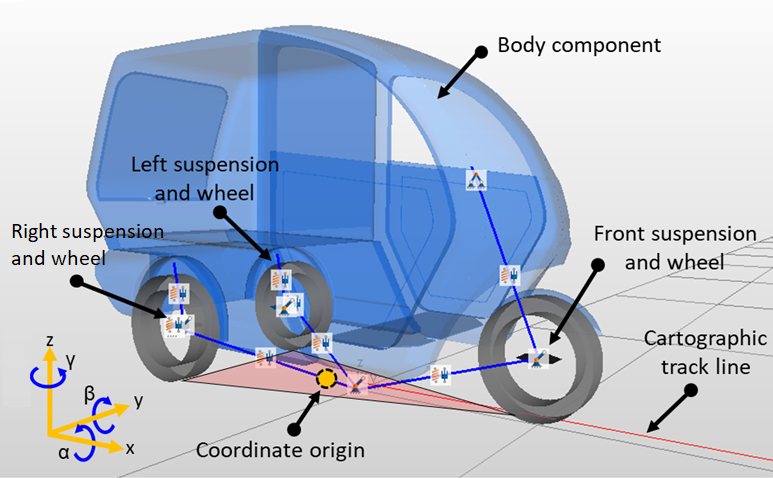Main Article Content
Abstract
This paper reveals the stability characteristics of an electric-powered delta trike (e-trike), which is developed for goods delivery services. The changeable center of gravity position and weight due to electric component placement and the carried good weight can cause instability of the e-trike. Three main parameters are firstly evaluated on the e-trike: 1) geometry, 2) center of gravity, and 3) stiffness and damping coefficient of the suspensions. Single Lane-Change (SLC) and Double Lane-Change (DLC) tests were then conducted following ISO 14791:2000 and ISO 3888-1:2018 standards, respectively. An e-trike model was created and simulated using SIMPACK, a multi-body dynamic software. The simulation results showed that the developed e-trike model can replicate SLC and DLC tests, indicating the model was valid. A parametric study with the validated model was then conducted with various e-trike weights, center of gravity position, and suspension stiffness and damping ratio values. The results showed additional weight and higher center of gravity position can decrease threshold velocity to avoid rollover. The low suspension stiffness also contributed to lower the threshold velocity. However, the damping coefficient value did not change the threshold velocity significantly. These results can be a guideline in designing a delta trike with better performance in stability and maneuverability.
Keywords
Article Details

This work is licensed under a Creative Commons Attribution-NonCommercial 4.0 International License.
References
- F. Arifurrahman, B. A. Budiman, and S. P. Santosa, “Static analysis of an electric three-wheel vehicle,” in 2018 5th International Conference on Electric Vehicular Technology (ICEVT), 2018, pp. 218–223.
- F. Arifurrahman, I. Indrawanto, B. A. Budiman, P. L. Sambegoro, and S. P. Santosa, “Frame modal analysis for an electric three-wheel vehicle,” in MATEC Web of Conferences, 2018, vol. 197, p. 8001.
- P. P. Dutta et al., “Design, FEA analysis and fabrication of a hybrid all terrain trike,” Aspects of Mechanical Engineering and Technology for Industry, vol. 2, pp. 97–103, 2014.
- H. Bunte and C. Hipp, “Recumbent bikes—trikes—velomobiles: An analysis of (single vehicle) crashes,” in Proceedings, International Cycling Safety Conference, 2015, pp. 15–16.
- J. C. Huston, B. J. Graves, and D. B. Johnson, “Three wheeled vehicle dynamics,” SAE Transactions, pp. 591–604, 1982.
- S. Shen, J. Wang, P. Shi, and G. Premier, “Nonlinear dynamics and stability analysis of vehicle plane motions,” Vehicle System Dynamics, vol. 45, no. 1, pp. 15–35, 2007.
- D. W. Karmiadji, M. Gozali, M. Setiyo, T. Raja, and T. A. Purnomo, “Comprehensive Analysis of Minibuses Gravity Center: A Post-Production Review for Car Body Industry,” Mechanical Engineering for Society and Industry, vol. 1, no. 1, pp. 31–40, 2021, doi: 10.31603/mesi.5250.
- R. Rajamani, D. Piyabongkarn, V. Tsourapas, and J. Y. Lew, “Real-time estimation of roll angle and CG height for active rollover prevention applications,” in 2009 American Control Conference, 2009, pp. 433–438.
- M. A. Rodríguez Licea, E. A. Vazquez Rodríguez, F. J. Perez Pinal, and J. Prado Olivares, “The rollover risk in delta tricycles: A new rollover index and its robust mitigation by rear differential braking,” Mathematical Problems in Engineering, vol. 2018, 2018.
- P. G. Van Valkenburgh, R. H. Klein, and J. Kanianthra, “Three-wheel passenger vehicle stability and handling,” SAE Transactions, pp. 605–627, 1982.
- M. A. Saeedi and R. Kazemi, “Stability of three-wheeled vehicles with and without control system,” 2013.
- C.-N. Chang and T.-T. Lee, “Stability analysis of three and four wheel vehicles,” JSME international journal. Ser. 3, Vibration, control engineering, engineering for industry, vol. 33, no. 4, pp. 567–574, 1990.
- M. Ataei, A. Khajepour, and S. Jeon, “Reconfigurable integrated stability control for four-and three-wheeled urban vehicles with flexible combinations of actuation systems,” IEEE/ASME Transactions on Mechatronics, vol. 23, no. 5, pp. 2031–2041, 2018.
- H. Furuichi, J. Huang, T. Fukuda, and T. Matsuno, “Switching dynamic modeling and driving stability analysis of three-wheeled narrow tilting vehicle,” IEEE/AsME Transactions on Mechatronics, vol. 19, no. 4, pp. 1309–1322, 2013.
- I. K. Reksowardojo et al., “Energy management system design for good delivery electric trike equipped with different powertrain configurations,” World Electric Vehicle Journal, vol. 11, no. 4, p. 76, 2020.
- F. Endrasari, D. W. Djamari, B. A. Budiman, and F. Triawan, “Rollover Stability Analysis and Layout Optimization of a Delta E-trike,” Automotive Experiences, vol. 5, no. 2, pp. 137–149, 2022.
- T. Gillespie, Fundamentals of vehicle dynamics. SAE international, 1992.
- A. I. Mahyuddin and P. Nurprasetio, “Design Calculation of Vehicle Suspension System,” 2005.
- A. H. Kazemian, M. Fooladi, and H. Darijani, “Rollover index for the diagnosis of tripped and untripped rollovers,” Latin American Journal of Solids and Structures, vol. 14, pp. 1979–1999, 2017.
- H. Pacejka, Tyre and Vehicle Dynamics, 2nd Editio. Oxford: Elsevier, 2006.
- A. Eichberger and G. Hofmann, “TMPT: multi-body package SIMPACK,” Vehicle System Dynamics, vol. 45, no. S1, pp. 207–216, 2007.

